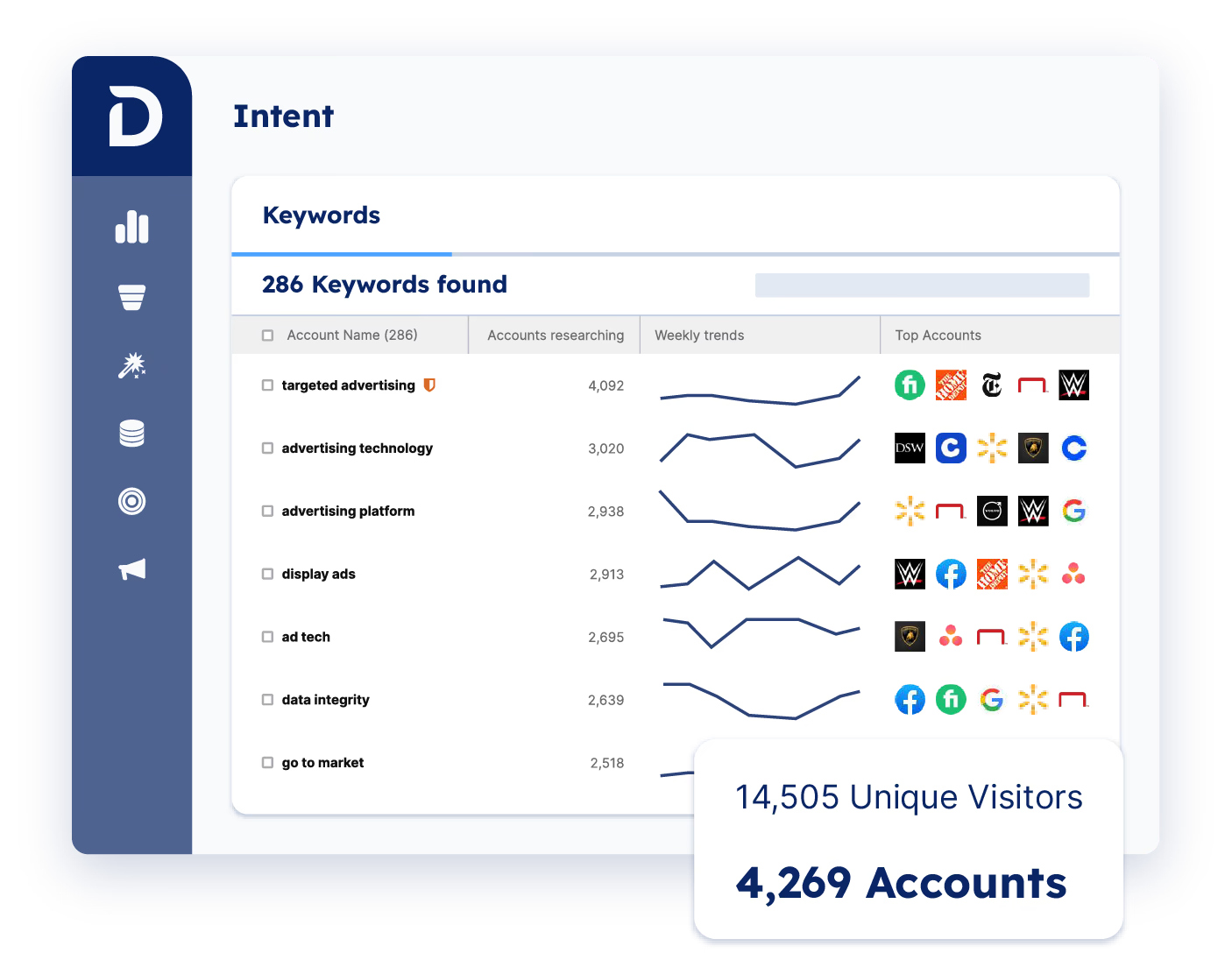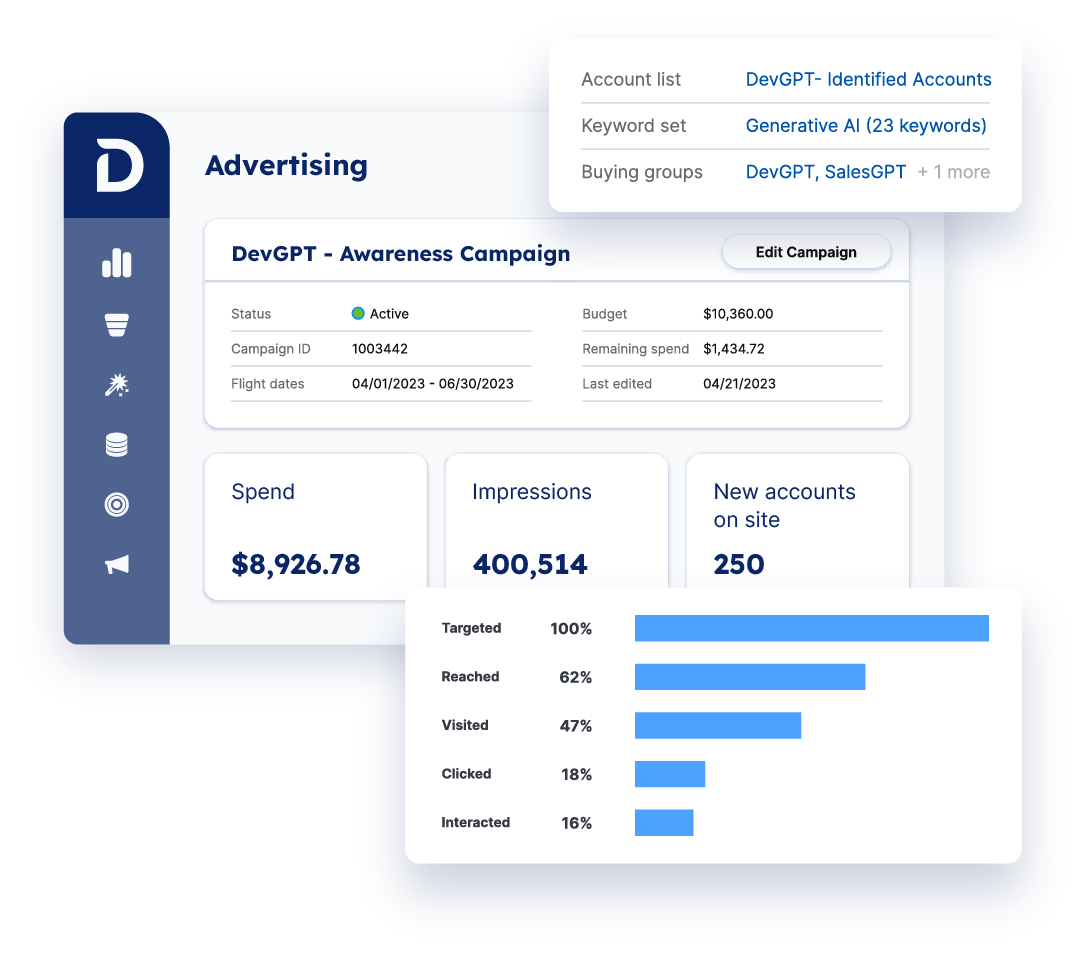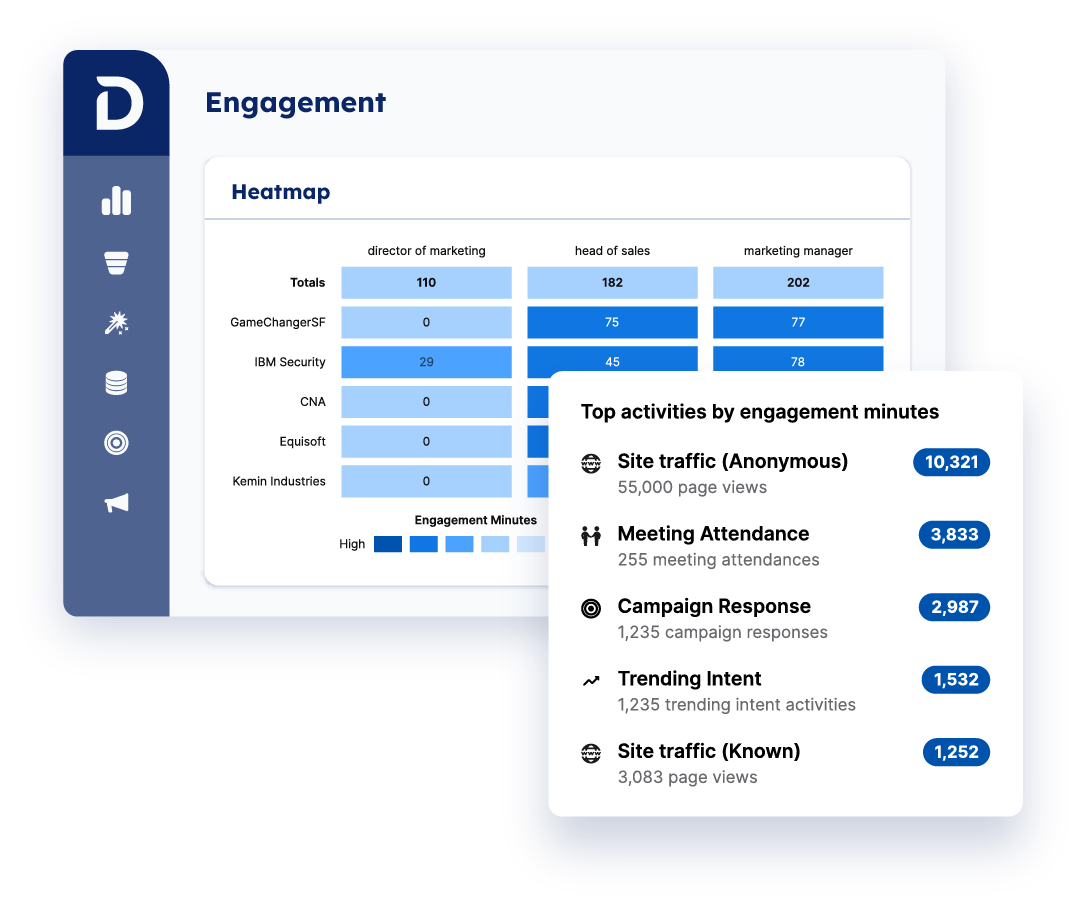How to Leverage AI in Marketing: Strategies and Best Practices
Learn how to leverage AI in marketing with a comprehensive guide covering predictive analytics, personalization, and automation, from implementation strategies to real-world examples.


What is AI Marketing?
AI marketing refers to using artificial intelligence tools to make marketing decisions and automate campaigns. It helps businesses analyze vast amounts of data, predict buying behavior, and create personalized experiences at scale.
Think of AI marketing as your ‘always-on digital assistant’ — the only difference is, this is powered by natural language processing (NLP). It processes customer data to spot patterns and make smart decisions about when, where, and how to reach your audience.
The technology learns from every interaction across the customer journey. When a customer clicks an email or browses your website, AI tools gather these insights to improve future campaigns.
Common AI marketing tools and their use cases include:
- Chatbots for 24/7 customer service
- Smart content optimization systems
- Automated ad-buying platforms for digital marketing initiatives
- Predictive analytics for customer behavior
These tools help cut costs and boost ROI by focusing on strategies that work. They handle the complex data work, letting marketers focus on creativity and strategy.
8 Ways to Use AI in Marketing
Predictive Lead Scoring
AI-powered lead scoring helps you spot your most promising potential customers using historical data. It analyzes how people interact with your business through various digital marketing touchpoints.
The system uses AI algorithms to rank leads based on their likelihood to buy. When someone downloads your case studies, visits your pricing page, or engages with your emails, AI adjusts their score automatically.
Here’s how it works:
- Collects data from various sources: This includes website visits, email interactions, CRM databases, and third-party intent data.
- Analyzes visitor behavior: Pages viewed, time spent on site, and company information like job role and industry.
- Compares patterns with your successful customers.
- Updates scores in real-time as leads take action.
For example, if someone from a mid-sized tech company views your product demos and attends your webinar, AI might flag them as a warm lead. This helps your sales team know exactly who to contact first.
The benefits are clear: your team spends more time with qualified leads and less time chasing dead ends. Plus, the system gets smarter over time as it learns which behaviors lead to sales.
Pro Tip → Demandbase One uses AI to analyze intent signals, engagement metrics, and firmographic data to rank your leads by their likelihood to convert.

Dynamic Pricing
AI helps you set the perfect price for your products at any moment. It tracks market trends, customer behavior, and competitor prices to adjust your pricing automatically.
Here’s how it works:
- Monitors competitor prices and market demand.
- Analyzes your sales history and inventory levels.
- Adjusts prices automatically during peak and slow times.
- Creates special offers for different customer groups.
For example, a SaaS platform might adjust enterprise package pricing during budget season when companies have fresh funds. Or a consulting firm might offer competitive rates for long-term service contracts when demand shifts in their industry.
The benefits are straightforward: you make more money by charging the right price at the right time.
Smart pricing also helps you increase customer satisfaction. You can offer volume discounts to growing companies while maximizing profit from high-value enterprise solutions.
The best part? Everything happens automatically. While you focus on running your business, AI ensures your prices stay competitive and profitable around the clock.
Email Marketing
AI makes your email campaigns smarter by knowing exactly who to email, when to send it, and what content will work best.
It studies how subscribers interact with your emails to improve every send. Rather than blasting the same email to everyone, AI-driven tools craft different messages for different groups.
A new subscriber might get a welcome series, while a loyal customer receives personalized product tips.
Here’s how it works:
- Groups subscribers based on their behavior.
- Creates custom content for different audiences.
- Picks the best time to send each email.
- Predicts who’s likely to buy (or unsubscribe).
For example, if a CTO downloads your cybersecurity whitepaper, AI might trigger a series of technical implementation emails. Or it could automatically send case studies when a decision-maker visits your pricing page multiple times.
AI also spots warning signs, like dropping engagement rates among key accounts. This helps you adjust your strategy before valuable prospects go cold.
Pro Tip → Demandbase One helps you send emails that speak directly to each account’s interests. For example, you can send tailored case studies or industry-specific offers based on a lead’s engagement history, ensuring every email hits the mark.
Ad Targeting and Optimization
AI transforms your ad campaigns by finding your perfect audience and delivering ads at the right moment. It does this by analyzing countless data points to predict who’s most likely to respond to your message.
Every click, view, and conversion teaches the system what works. AI then adjusts your ad spend instantly, moving money away from underperforming ads and toward winning combinations.
Here’s what AI handles:
- Matches ads to user interests and behaviors.
- Tests different versions across audiences.
- Predicts the best times to show your ads.
- Adjusts bids automatically for better ROI.
Picture selling enterprise software. AI might notice your ads perform best with IT directors viewing tech news during business hours. It then increases bids for this audience while lowering spend on less relevant viewers.
Beyond targeting, AI crafts personalized ad experiences. A CFO searching for “financial automation” might see ROI-focused messaging, while a CTO sees technical integration benefits.
Pro Tip → With Demandbase One, you can integrate intent data into your ad campaigns, identifying accounts actively searching for solutions like yours. This helps you target decision-makers when they’re most likely to consider your product.
Content Creation and Search Engine Optimization (SEO)
AI solutions now power how marketers develop and optimize their content — simply by analyzing what enterprise buyers are searching for. It studies industry trends, competitor content, and search patterns to help you create material that ranks and converts.
For example, platforms like Clearscope or Jasper.ai can provide suggestions based on keyword analysis or audience preferences.
Other solutions like Copy.ai can also help keep your tone consistent, saving you time on repetitive tasks.
Here’s how it works:
- Identifies trending topics in your industry.
- Suggests technical keywords that drive traffic.
- Optimizes content for enterprise search intent.
- Tracks how content performs with key accounts.
For example, if procurement officers frequently search for “vendor compliance requirements,” AI helps create targeted content addressing these concerns. When CTOs research “enterprise cloud migration,” it suggests optimizing existing content with the technical specifications they’re searching for.
The system also spots when technical content needs updating. When a whitepaper about implementation processes starts losing traction, AI recommends updates based on new industry requirements or pain points.
Sentiment Analysis
Sentiment analysis uses AI to interpret and classify customer feedback, reviews, and social media posts into positive, negative, or neutral sentiments. It helps you understand how B2B clients really feel about your products or services in real time.
Think of it as having thousands of conversations with customers at once. AI processes this feedback to spot trends, potential issues, and opportunities for improvement.
Here’s how marketers use it:
- Monitors social media and review platforms.
- Analyzes customer support interactions.
- For example, words like “love” and “excellent” may indicate positive sentiments, while “frustrated” or “terrible” suggest negative feelings.
- Tracks feedback from different company roles.
- Identifies emerging concerns or praise.
For example, when IT managers discuss your enterprise software on LinkedIn, AI gauges their satisfaction with implementation processes. Or if procurement teams mention your service in industry forums, it spots common pain points about contract terms.
The system also alerts you to shifting sentiments. If technical decision-makers start expressing concerns about a new feature, you can address issues before they affect client retention.
Pro Tip → Demandbase One analyzes billions of behavioral signals—such as website visits, content downloads, and keyword searches. It then highlights the content they engage with and their level of interest, giving you a clear roadmap of where to focus your efforts.
Recommended → AI’s Potential to Help B2B Companies with Revenue Goals
Scaling A/B Testing
A/B testing involves comparing two or more variations of marketing campaigns. In this case, it’s comparing different versions of your content, emails, and landing pages to find what resonates best with decision-makers.
With the use of AI, this goes a step further. Unlike the ‘static model’ of A/B testing, AI adjusts test parameters depending on several factors. If one variation outperforms others early, AI can allocate more traffic to it, optimizing results faster and improving user experience.
Here’s how it works:
- Tests multiple page variations simultaneously.
- Analyzes which messages convert better.
- Optimizes for different decision-maker roles.
- Adjusts tests based on real-time results.
For example, when launching a new enterprise software solution, AI might test different value propositions for CTOs versus CFOs. It could compare technical specification-focused content against ROI-centered messaging to see which drives more qualified leads.
Pro Tip → Use Demandbase One to identify which audience segments to test. By targeting high-intent accounts with different messages or offers, you can quickly determine the most effective approach, ensuring faster and more meaningful results.
Multilingual Campaigns
AI breaks down language barriers in your global marketing efforts. It automatically translates and adapts your content for different markets while maintaining technical accuracy and industry context.
Here’s how it works:
- Translates technical documentation accurately.
- Adapts content for regional business practices.
- Maintains consistent industry terminology.
- Updates all language versions simultaneously.
For example, when rolling out your SaaS platform documentation, AI accurately translates cloud architecture terms for German IT teams while adapting compliance language for Japanese regulators. Or it helps localize your implementation guides so they resonate with both Brazilian system integrators and French enterprise architects.
Beyond translation, AI ensures your content follows local business customs. A whitepaper that works for UK procurement teams gets adjusted to match how US enterprises evaluate vendors.
Common Challenges of Using AI in Marketing (and How to Overcome Them)
Data Privacy and Security
AI marketing depends heavily on customer data to create personalized campaigns and predict behaviors.
However, this reliance introduces major privacy and security risks, especially when handling sensitive information like personal details and purchase histories. Furthermore, marketers today also face growing threats from cyberattacks, data breaches, and unauthorized access. These risks don’t just compromise customer trust – they can lead to serious regulatory penalties. Privacy laws like GDPR and CCPA make this challenge even more complex.
These regulations enforce strict rules on how you collect, process, and store data, with hefty fines for non-compliance.
Solution:
- Encrypt all customer data during both transmission and storage to prevent unauthorized access.
- Use anonymization techniques to remove personally identifiable information (PII) while keeping the insights your AI needs.
- Regular security audits are crucial. Check your data practices often to spot weaknesses and ensure you’re following all privacy standards.
Data Quality and Bias
AI marketing tools rely completely on the quality of data they learn from. Poor or incomplete data leads to poor decision-making and marketing campaigns that miss the mark, wasting both time and money.
Bias in your data creates an even bigger problem. When your historical marketing data favors certain groups, your AI tools might accidentally discriminate in their targeting and recommendations.
Solution:
- Keep your marketing data clean and standardized through regular updates and checks. This ensures your AI tools work with accurate, current information when making decisions.
- Check your AI models regularly for bias by auditing their outputs and recommendations. Look for signs that they might favor certain groups unfairly.
- Build your AI systems using diverse, representative data sets. This helps create marketing campaigns that connect with all your potential customers, not just a select few.
Lack of Expertise and Skills Gap
Adopting AI marketing tools requires specialized knowledge that many teams don’t have. Most marketers lack training in data science, machine learning, and AI platforms, making it hard to use these powerful tools effectively.
In addition, AI technology changes rapidly, demanding constant learning and adaptation. Without proper training, marketing teams struggle to understand AI insights, make data-driven choices, or fix technical problems when they arise. This knowledge gap leads to expensive AI tools sitting unused or misused.
Companies risk falling behind competitors who better understand and use AI in their marketing strategies.
Solution:
- Invest in AI training for your marketing team through workshops and certification programs. Regular training helps your team stay current with AI developments and use tools confidently.
- Partner with AI experts or hire specialists to fill crucial knowledge gaps. These experts can guide your team and ensure you’re using AI marketing tools to their full potential.
- Choose AI platforms that offer clear interfaces and strong support resources. User-friendly tools help your existing team adopt AI more easily while they build their technical skills.
High Implementation Costs
Using AI marketing platforms often requires a major upfront investment. Companies face costs for software licenses, system upgrades, expert staff, and integration work – making it tough for smaller businesses to get started.
The ongoing expenses add up quickly too. You’ll need to budget for maintenance, training AI models, and storing large amounts of data. These continuing costs can strain marketing budgets, especially when the return on investment isn’t clear right away. Making mistakes during implementation can waste significant resources.
hen expensive AI tools don’t deliver the expected results, companies become hesitant to invest in new marketing technology.
Solution:
- Begin with basic AI tools that address your most pressing marketing needs. Choose tools that can grow with your business instead of investing in complex systems right away.
- Look for AI platforms that offer flexible payment options like monthly subscriptions. These payment models help spread costs over time and reduce initial financial pressure.
- Test AI solutions with small pilot projects before full implementation. This helps prove the value of AI marketing tools and builds confidence for bigger investments later.
Maintaining Human Connection
While AI performs well at analyzing data and automating tasks, it struggles with emotional intelligence and creativity. Relying too heavily on AI makes your marketing feel robotic and impersonal, missing the human elements that build real connections with customers.
This is because AI tools often miss subtle communication cues that humans naturally understand. When AI handles customer interactions, it might overlook important context or cultural nuances, potentially damaging relationships instead of strengthening them. This becomes especially critical in B2B relationships where trust and understanding are essential.Complex business decisions require human insight and empathy that AI simply can’t replicate.
Solution:
- Let AI handle data analysis and routine tasks while keeping humans in charge of relationship building. Use automation to free up your team’s time for meaningful client conversations and strategic thinking.
- Combine AI insights with human expertise to create deeper customer connections. Use AI’s data analysis to understand client needs, but let your team deliver this understanding through authentic, personalized engagement.
Remember that AI should enhance, not replace, the human side of marketing. The best results come from finding the right balance between efficient automation and genuine human interaction.
Integration with Existing Systems
Connecting AI tools with your current marketing systems creates significant challenges. Many businesses struggle to make AI work smoothly with their CRM, email platforms, and other existing tools, especially when dealing with older systems. When systems don’t communicate well, they create isolated pools of data.
This fragmentation prevents AI from accessing all the customer information it needs to make accurate predictions and provide valuable insights. Poor integration leads to other problems too. Implementation takes longer, costs rise, and you need technical experts to bridge the gaps between different systems.
Solutions:
- Select AI platforms that already connect with your existing marketing tools. Look for solutions with strong API capabilities to ensure they’ll work well with your current technology stack. For more complex integrations, consider leveraging data integration platforms to bridge the gap between your AI tools and existing systems.
- Check your systems thoroughly before adding AI tools. Understanding potential compatibility issues early helps you plan for and solve them effectively.
- Consider adding AI tools gradually, starting with your most important marketing areas. This step-by-step approach helps minimize disruption while ensuring each integration works properly.
Implementing AI in Your Marketing Strategy (Step-by-Step Guide)
Step 1: Define Clear Objectives
Begin by identifying specific challenges or areas where AI can add value. Think about specific challenges in your current marketing efforts that AI could solve.
This might include improving how you target key accounts or automating routine tasks, making traditionally time-consuming tasks more efficient.
Key questions to ask:
- Are you looking to enhance customer experience?
- Do you need to improve lead generation?
- Are you aiming to optimize ad targeting?
DB Nuggets → Set measurable goals that directly tie to your business objectives. Instead of vague aims like “improve marketing,” target specific metrics such as “increase enterprise lead quality by 25%” or “reduce response time to customer inquiries by 50%.”
Step 2: Audit Your Existing Data
Before implementing AI tools, take a close look at your existing data. AI needs clean, reliable data to deliver accurate insights, making this step crucial for success.
- Start by examining all your data sources. Look through your CRM records, marketing analytics, customer interactions, and campaign results to understand what information you already have.
- Check your data quality carefully. Bad data leads to bad AI decisions, so look for problems like outdated information, duplicate entries, or missing fields that could affect AI performance.
- Ensure all data entries follow a consistent format, such as:
- Uniform date formats (e.g., DD/MM/YYYY).
- Standardized naming conventions for customer titles or product categories.
- Ensure all data entries follow a consistent format, such as:
- Create a clear picture of your data gaps. Know which customer insights you’re missing, whether it’s detailed behavior tracking, engagement metrics, or account-level intelligence.
- Consider how your data flows between systems. AI needs consistent access to information, so understanding how data moves through your marketing stack is essential.
DB Nuggets → Use data cleaning tools to automate the process of removing duplicates, filling gaps, and standardizing data formats.
Step 3: Select the Right AI Tools
Finding the perfect AI tools means matching solutions to your specific marketing needs. Not all AI tools are created equal, and choosing incorrectly can waste valuable time and resources.
- Focus first on tools that solve your biggest marketing challenges.
- If lead quality is your main concern, look at AI-powered lead scoring platforms. If personalization is critical, explore content optimization tools
- Evaluate each tool against practical criteria. Consider how easily it fits into your current systems, whether your team can learn it quickly, and if it can grow with your business needs.
- Watch out for common selection pitfalls. Fancy features mean nothing if your team can’t use them, or if the tool won’t connect properly with your existing marketing stack.
DB Nuggets → Test thoroughly before committing. Most AI vendors offer trial periods – use these to ensure the tool performs well in your specific business context and delivers real value.
Step 4: Start Small with a Pilot Project
Start with a focused test project instead of a complete overhaul. Pick one specific marketing challenge where AI could make an immediate, measurable difference.
- Choose a pilot that affects a limited part of your marketing operations. This might mean testing AI-powered email optimization for one campaign type or using predictive analytics for a single market segment.
- Set clear success metrics for your pilot. Track specific numbers like improvement in lead quality, response rates, or time saved to prove the AI tool’s value.
- Keep your initial scope narrow and manageable. A smaller pilot helps you spot problems quickly and adjust your approach without risking major disruption to your marketing efforts.
DB Nuggets → Use clear KPIs to measure pilot success, such as lead conversion rates, customer engagement levels, or cost savings.
Step 5: Train Your Team
AI marketing tools are only as effective as the people managing them.
- Start with comprehensive training that covers both basic operations and strategic applications.
- Create a learning environment that encourages questions and experimentation.
- Your team needs to feel comfortable working with AI tools before using them in real marketing campaigns.
- Consider different learning needs across your team. While some members might need technical training, others may need help understanding how to interpret AI-generated insights.
DB Nuggets → Pair technical training with regular workshops to explore creative ways AI can enhance marketing campaigns.
Step 6: Integrate AI into Your Marketing Workflow
After your pilot works, start adding AI tools to your main marketing tasks. Focus on areas where automation can make the biggest impact right away.
- Connect your new AI tools with your current marketing systems. Make sure they work smoothly with your CRM, email platforms, and other marketing software.
- Start with simple processes like email personalization or ad targeting. These quick wins help your team see AI’s value while building confidence in the technology.
- Watch how your team uses the new AI tools. Make adjustments based on their feedback and any challenges they face.
DB Nuggets → Get help from tech experts during integration. They can spot potential problems and ensure your AI tools connect properly with existing systems.
Step 7: Monitor and Optimize Performance
Track your AI tools’ performance daily to ensure they deliver real results. Watch key numbers like conversion rates and engagement to spot any problems early.
- Test different approaches to see what works best. Run A/B tests on your campaigns to find winning combinations.
- Make changes based on what the data shows you. If something isn’t working, adjust your AI settings or try new strategies.
- Keep your team informed about performance results. Share both wins and challenges so everyone understands how AI impacts their marketing efforts.
DB Nuggets → Use performance data to retrain AI models and improve accuracy.
Step 8: Address Ethical and Regulatory Concerns
Make sure your AI marketing follows all privacy laws and ethical guidelines. Different regions (e.g., GDPR, CCPA) have different rules about how you can collect and use customer data.
- Get clear permission before collecting any customer information. Tell people exactly how you’ll use their data and what AI tools will access it.
- Keep customer data safe through proper security measures. Use encryption and anonymization to protect sensitive information.
- Watch for bias in your AI marketing decisions. Check that your tools treat all customer groups fairly and don’t discriminate.
- Stay transparent about how you use AI in marketing. Let customers know when they’re interacting with AI tools versus human team members.
DB Nuggets → To avoid fines and penalties, put someone in charge of keeping AI practices ethical. This person should monitor compliance and keep up with changing privacy regulations.
6 Game-Changing AI Marketing Tools
AI for Advertising and ABM
These tools allow marketers to identify high-value accounts, create personalized campaigns, and optimize ad performance in real-time. They work by using real-time data to improve ROI and create deeper connections with target audiences.
Recommendations:
- Demandbase: Provides an AI-powered ABM platform that identifies, prioritizes, and engages best-fit accounts for your business. It tracks intent data and real-time signals to help create targeted campaigns that match what key accounts need.
Benefit → Helps you target the right accounts more precisely. You spend less on wasted ads and build stronger customer relationships through personalized messaging. Recommended → How AI Can Supercharge Your Account-Based Marketing Strategy

AI Content Creation
AI content creation tools help marketers produce quality materials faster and more efficiently. These platforms use advanced AI to generate everything from blog posts to ad copy while maintaining your brand voice.
Recommendations:
- Jasper.ai: Creates various types of marketing content including blogs, ads, and social media posts. Its AI ensures content stays relevant to your audience and matches your marketing goals.
- Copy.ai: Offers ready-to-use templates for quick marketing copy creation. You input your key details, and it generates professional content for different marketing channels.
Benefit → Speeds up content creation while keeping your brand message consistent. Your team saves time and can focus on strategy instead of writing routine content.
AI for SEO and Content Optimization
AI-powered SEO tools help your content rank higher in search results. These platforms analyze successful content in your industry and show you exactly how to improve your own pages.
Recommendations:
- SurferSEO: Studies over 500 ranking factors from top-performing pages. It shows you how to optimize everything from keyword placement to content structure, helping you match what works in your industry.
- Clearscope: Checks your content quality and SEO performance as you write. It compares your work to top-ranking pages and suggests improvements to help you create better content.
Benefit → Takes the guesswork out of SEO. You create content that both search engines and readers love, leading to more organic traffic and better conversion rates.
AI for Email Marketing
Email tools using AI make your campaigns smarter by finding the best times to send and personalizing content for each subscriber. These platforms analyze recipient behavior to improve open rates and engagement.
Recommendations:
- Seventh Sense: Studies when each person on your list typically reads emails. It then sends your messages at the perfect time for each recipient, boosting open rates and responses.
- Mailchimp: Uses AI to help create better email content and understand your audience. It suggests improvements to your messages and helps segment your list for more targeted campaigns.
Benefit → Helps you send the right message to the right person at the right time. Your emails get better results because they’re more relevant and arrive when subscribers are ready to read them.
AI Customer Data Platforms (CDPs) and Personalization
AI-powered CDPs gather all your customer data in one place to create personalized experiences. These platforms analyze customer behavior across channels to help you deliver the right message every time.
Recommendations:
- Optimove: Combines customer data and AI to create targeted marketing campaigns. It watches how customers interact with your brand and helps send personalized messages that increase engagement.
- Blueshift: Brings together customer information from different sources in real time. It predicts what customers might do next and helps you reach them with relevant content at the right moment.
Benefit → These AI platforms help you truly understand your customers and deliver the experiences they want. You create stronger relationships by sending messages that match each customer’s needs and interests.
AI Chatbots and Conversational Marketing
AI chatbots handle customer conversations 24/7, answering questions and qualifying leads automatically. These tools bots natural conversations that feel personal while saving your team time. Recommendations:
- Drift: Uses AI to talk with website visitors like your best sales reps would. It helps identify qualified leads and starts sales conversations instantly when prospects show interest.
- Intercom: Offers smart chatbots powered by GPT-4 for natural customer support. Its AI handles common questions and knows when to bring in human agents for complex issues.
- ChatGPT: Offers conversational AI capabilities that simulate human-like interactions. It automates FAQs, assists with troubleshooting, and improves response times.
Benefit → These AI chatbots help you respond to customers instantly at any time. You convert more leads and keep customers happy while your support team focuses on complex issues.
5 Top Companies Using AI to Improve Their Marketing Strategies
Netflix Improves User Engagement
- Challenge: Netflix needed to keep subscribers engaged in a crowded streaming market. Finding the right content for each viewer became crucial for reducing cancellations.
- AI Solution: The platform studies how each viewer behaves and what they enjoy watching. It looks at everything from viewing history to how long people watch specific shows.
- Results: The recommendation system now drives most of Netflix’s viewership. Subscribers spend more time watching because they find shows they like faster. Better content suggestions have helped Netflix keep subscribers longer. Viewers who get relevant recommendations are more likely to stay subscribed.
Coca-Cola Creates Content with Generative AI
- Challenge: Coca-Cola needed fresh content that would work across many different markets. Creating unique materials for each region while keeping their brand consistent was becoming difficult.
- AI Solution: The company created “Create Real Magic,” a platform that turns brand assets into new artwork. They combined advanced AI tools (OpenAI’s GPT-4 and DALL-E technologies) to help digital artists worldwide create fresh takes on Coca-Cola’s classic elements.
- Results: The campaign sparked a wave of original artwork from creators worldwide. Artists produced unique content that felt fresh while staying true to Coca-Cola’s brand. The project showed how AI could help create content faster without losing quality. It turned fans into creators and gave Coca-Cola fresh material for different markets.
Sephora Taps Into Smart Customer Service
- Challenge: Sephora wanted to help customers get beauty advice whenever they needed it. Traditional customer service couldn’t keep up with growing online and in-store questions.
- AI Solution: The company built a smart chatbot that could suggest products and share makeup tips. It learned from each conversation to give better, more personal advice to shoppers.
- Results: Customers got answers faster and found products they loved more easily. The chatbot handled routine questions, letting human staff focus on complex customer needs. More shoppers bought products after chatting with the AI helper. They felt more confident in their choices because they got personalized suggestions.
Amazon Knows Your Next Purchase
- Challenge: The largest e-commerce company, Amazon, wanted to guess what customers might buy next. With millions of products, helping shoppers find what they want quickly became essential.
- AI Solution: The company built tools that study how people shop on their site. These tools watch what customers browse, buy, and how they interact with different products.
- Results: Product recommendations now drive a large part of Amazon’s sales. Customers find things they want faster, often buying items they didn’t know they needed. The personalized shopping experience keeps customers coming back. They spend more time browsing because the suggestions match their interests.
Starbucks Takes it Beyond Coffee
- Challenge: Starbucks wanted to make its rewards program feel more personal. Generic offers weren’t exciting customers or encouraging repeat visits.
- AI Solution: They built a system that learns from every customer purchase and visit. The app watches when people buy coffee, what they order, and which stores they prefer.
- Results: Regular customers started spending more on each visit. People used the app more often because the rewards felt made just for them. The program helped Starbucks understand its customers better. They learned when people visit, what they like, and how to keep them coming back.
Level Up Your Marketing with Demandbase One
The old approach of collecting as many leads as possible doesn’t work anymore. It wastes time and resources on prospects who aren’t ready to buy.
Companies need a smarter way to spot their best potential customers. Understanding which accounts are ready to engage streamlines your marketing efforts. And what better tool to do that than Demandbase One — a comprehensive platform that completely transforms how you identify, engage, and convert your ideal customers?

Why Demandbase One?
- Account Intelligence: Know Exactly Who to Target
Demandbase One gathers and analyzes intent signals, behavioral data, and firmographics to provide a 360-degree view of your target accounts.
- Predictive Analytics: Anticipate Engagement Readiness
The platform uses predictive models to determine which accounts are most likely to engage based on historical data and intent signals.
- Personalization at Scale: Tailor Every Interaction
With AI-powered personalization, Demandbase One adapts your messaging and content to the specific needs, challenges, and preferences of each account.
- Cross-Channel Engagement: Unify Your Marketing Efforts
Demandbase One integrates seamlessly with your existing tech stack, enabling consistent messaging and targeting across email, ads, website interactions, and more.
And we don’t just say all these — we prove it too;
With Demandbase One, no more second-guessing about which accounts to target or when to reach out. No more disconnected data points or siloed customer insights. Instead, you get a clear, actionable view of your entire target market, powered by AI that gets smarter with every interaction. Whether you’re running ABM campaigns, orchestrating multi-channel outreach, or aligning with sales on account prioritization, Demandbase One ensures you’re always making moves that matter.
Ready to See Your Accounts’ True Intent? → See Demandbase One in Action

We have updated our Privacy Notice. Please click here for details.



